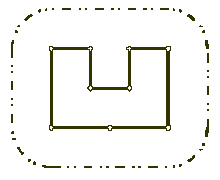Wall
| Time Limit: 1000MS | Memory Limit: 10000K | |
| Total Submissions: 33446 | Accepted: 11376 |
Description
Once upon a time there was a greedy King who ordered his chief Architect to build a wall around the King's castle. The King was so greedy, that he would not listen to his Architect's proposals to build a beautiful brick wall with a perfect shape and nice tall towers. Instead, he ordered to build the wall around the whole castle using the least amount of stone and labor, but demanded that the wall should not come closer to the castle than a certain distance. If the King finds that the Architect has used more resources to build the wall than it was absolutely necessary to satisfy those requirements, then the Architect will loose his head. Moreover, he demanded Architect to introduce at once a plan of the wall listing the exact amount of resources that are needed to build the wall.

Your task is to help poor Architect to save his head, by writing a program that will find the minimum possible length of the wall that he could build around the castle to satisfy King's requirements.
The task is somewhat simplified by the fact, that the King's castle has a polygonal shape and is situated on a flat ground. The Architect has already established a Cartesian coordinate system and has precisely measured the coordinates of all castle's vertices in feet.

Your task is to help poor Architect to save his head, by writing a program that will find the minimum possible length of the wall that he could build around the castle to satisfy King's requirements.
The task is somewhat simplified by the fact, that the King's castle has a polygonal shape and is situated on a flat ground. The Architect has already established a Cartesian coordinate system and has precisely measured the coordinates of all castle's vertices in feet.
Input
The first line of the input file contains two integer numbers N and L separated by a space. N (3 <= N <= 1000) is the number of vertices in the King's castle, and L (1 <= L <= 1000) is the minimal number of feet that King allows for the wall to come close to the castle.
Next N lines describe coordinates of castle's vertices in a clockwise order. Each line contains two integer numbers Xi and Yi separated by a space (-10000 <= Xi, Yi <= 10000) that represent the coordinates of ith vertex. All vertices are different and the sides of the castle do not intersect anywhere except for vertices.
Next N lines describe coordinates of castle's vertices in a clockwise order. Each line contains two integer numbers Xi and Yi separated by a space (-10000 <= Xi, Yi <= 10000) that represent the coordinates of ith vertex. All vertices are different and the sides of the castle do not intersect anywhere except for vertices.
Output
Write to the output file the single number that represents the minimal possible length of the wall in feet that could be built around the castle to satisfy King's requirements. You must present the integer number of feet to the King, because the floating numbers are not invented yet. However, you must round the result in such a way, that it is accurate to 8 inches (1 foot is equal to 12 inches), since the King will not tolerate larger error in the estimates.
Sample Input
9 100 200 400 300 400 300 300 400 300 400 400 500 400 500 200 350 200 200 200
Sample Output
1628
Hint
结果四舍五入就可以了
Source
据题意可得: 所求结果为凸包周长+ 2*PI* L ;
转个分析:
证明如下:假如顺时针给出四个点A、B、C、D。组成了凸四边形ABCD。我们不妨过A点作AE垂直于AB,同时过A点再作AF垂直于AD,过B点作BG、BH分别垂直于AB、BC。连结EG,垂线段的长度为L,过A点以AE为半径作一段弧连到AF,同理,使GH成为一段弧。此时EG=AB(边),AB段城墙的最小值为EF+弧EF+弧GH=AB+弧EF+弧GH。对所有点进行同样的操作后,可知城墙的最小值=四边形的周长+相应顶点的弧长(半径都为L)之和。
下面证明这些顶点弧长组成一个圆。依然以前面的四边形为例。A、B、C、D四顶点各成周角,总和为360*4=1440度,四边形内角和为360度,每个顶点作两条垂线,总角度为4*2*90=720度,所以总圆周角为1440-360-720=360度,刚好组成圆。
所以四边形ABCD的围墙最短= 四边形的周长+圆周长。
推广到任意多边形,用同样的方法,城墙最短=凸包的周长 + 以L为半径的圆的周长。
首先,我们得出城墙最短=凸包的周长 + 相应顶点的弧长(半径都为L)之和。
再证明 相应顶点的弧长(半径都为L)之和=以L为半径的圆的周长。
事实上,设凸包顶点为n,n个顶点组成n个周角,角度为360*n=2*180*n,凸包的内角和为180*(n-2),作了2*n条垂线,和为2*n*90=180*n,所以总圆周角为2*180*n-180*(n-2)-180*n=360,组成圆。
#include <cmath> #include <cstdio> #define PI acos(-1.0) #define MAXN 1001 #include <iostream> #include <algorithm> using namespace std; struct point { int x, y; } ; point list[MAXN]; int stack[MAXN], top; int cross(point p0, point p1, point p2) //叉乘, p0p1 X p0p2; { return (p1.x-p0.x)*(p2.y-p0.y) - (p1.y-p0.y)*(p2.x-p0.x); } double dis(point p1, point p2) { return sqrt((double)(p2.x-p1.x)*(p2.x-p1.x) + (p2.y-p1.y)*(p2.y-p1.y)); } bool cmp(point p1, point p2) //极角排序, { int tmp=cross(list[0], p1, p2); if(tmp > 0) return true; else if(tmp==0&& dis(list[0], p1) < dis(list[0], p2)) return true; else return false; } void init(int n) //找出左下角的点放在list[0] 中 ; { point fv; scanf("%d%d", &list[0].x, &list[0].y); fv.x= list[0].x; fv.y=list[0].y; int k=0; for(int i=1; i<n; i++) { scanf("%d%d", &list[i].x, &list[i].y); if( (fv.y >list[i].y) || (fv.y==list[i].y && fv.x>list[i].x)) { fv.x= list[i].x; fv.y =list[i].y; k=i; } } list[k]= list[0]; list[0]=fv; sort(list+1, list+n, cmp) ; } void graham(int n) { if(n==1) {top=0; stack[0]=0;} if(n==2) {top=1; stack[0]=0; stack[1]=1;} if(n >2) { for(int i=1; i<=1; i++) stack[i]=i; top=1; for(int i=2; i<n; i++) { while(top >0 && cross(list[stack[top-1]], list[stack[top]], list[i]) <= 0) top--; //找最外围的点 ; top++; stack[top]= i; } } } int main() { int N, L; while(scanf("%d%d", &N, &L) != EOF) { init(N); graham(N); double res= 0; for(int i=0; i<top; i++) res+= dis(list[stack[i]], list[stack[i+1]]); res +=dis(list[stack[0]], list[stack[top]]); res += 2*PI*L; //printf("%d ", (int)(res+0.5)); printf("%.lf ", res ); } return 0; }